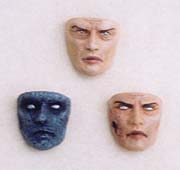
|
Symbolization designates the subject’s endeavor, always fragmentary and ultimately doomed to fail, to bring into the light of the day, by way of Symbolic representatives, the Real of bodily drives excluded by Imaginary identification; it is therefore a kind of compromise formation by way of which the subject integrates fragments of the ostracized Real. (64) |

|
A Lacanian topology of subjectivity that portrays self-/knowledge as being determined by Other as well as represents an annihilation of distance parallels Foucault's sixteenth-century epistemology and cyberspace phenomenology, and suggests how we may even approach the Real, as Zizek claims we do, for those precious fragments of identity. Bruce Fink has likened the Lacanian subject to a Möbius strip, where two sides of a band come together as one through a particular twisting; the I is split into ego and unconscious, bringing into being “a [self] with two sides: one that is exposed and one that is hidden” (45). Each half of the Lacanian subject ultimately begins on its own side but then eventually “wind[s] up on the flip side due to the twist in the strip” even though there is a “locally valid split between front and back, conscious and unconscious” (45). The Freudian slip of the tongue is the popular example of the Möbius-like merging and parting of the unconscious and conscious.
